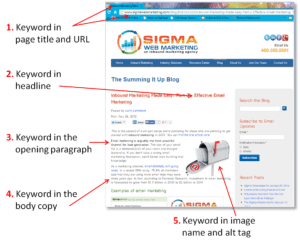 For many prospective customers, your blog will be their first introduction to your company – that is if they find your blog in the first place. Sure it’s possible that people may run across your content on social media or if you’re really lucky a share from a colleague. But, the fact is 63% of business leaders say they use online search as a primary tool to find content
For many prospective customers, your blog will be their first introduction to your company – that is if they find your blog in the first place. Sure it’s possible that people may run across your content on social media or if you’re really lucky a share from a colleague. But, the fact is 63% of business leaders say they use online search as a primary tool to find content
But how do you make sure you’re actually getting the most out of the SEO in your blogs? We’ve created an SEO checklist that you can use to ensure that you are following the best blogging practices for SEO.
1) Choose 1 or 2 long-tailed keywords
When it comes to keywords in your blog it’s important to remember that less is more. Instead of stuffing your blog full of a bunch of different keywords; focus on 1-2 long tailed keywords for each post. Why?There are two reasons; first, search engines will actually penalize your post if it looks like you’re using keywords too many times(spam anyone.) Second it helps keep you focused on a goal for your post. Yes, more than one keyword may appear in a post; but the goal of the post should be narrow enough to allow you to spend time optimizing for just one or two keywords.
Now that you have a focus it’s time to thoughtfully sprinkle these keywords in just the right places to maximize their effectiveness.
a) Title
Your keyword should be included in the title of your blog post. The title of your post will be crawled by the search engine and your reader’s first step in determining the relevance of your content. So, including a keyword here is vital. But, remember to follow best blogging practice and keep the total number of characters for your blog title under 70.
b) Body
Gone are the days of keywords randomly being placed in content – whether or not they actually makes sense. You should mention your keyword at a normal pace throughout your post — that means you should include your keywords, but only in a natural, reader-friendly way. Search engines penalize any post they believe is using keyword mentions as a way to rank for a particular keyword, so this requires close attention in the writing process.
c) URL
If your URL includes your blog title then you should automatically have your keyword in your URL. If you need to shorten your blog post URL, make sure you keep the keyword in it.
2) Use responsive design.
In April, Google updated its search algorithm so that comparable mobile sites will rank higher than non-mobile friendly sites in mobile search results. That means your website – and blog must be responsive and conform to the screen of any device. That means whether you’re reading a blog on a desktop, smartphone, tablet, or other mobile devices, the site format and layout will be the same, making for a unified user experience. Responsive design is becoming more and more important for SEO.
A responsive design set up also helps create one URL which helps your SEO. Having one URL means that any inbound links that come back to your site won’t be scattered across different domains.
3) Optimize Meta Descriptions
Meta descriptions give search engines and your readers information about your blog post’s content before they actually click. Make sure your meta description includes the long-tail keyword you are trying to rank for. In the example above, I searched for SEO keyword strategy and Google penalty. The words SEO keyword strategy and Google penalty are both bolded because they were the terms I was looking to find. So be certain to use your long-tail term clearly here so Google and your audience are well aware of the post’s content

4) Don’t forget about images
Images can be just as important when it comes to SEO. It’s not because the search engines look for images, rather they look for images with alt text. You can find an image’s alt text by placing your cursor over an image. This photo was found in the images section by searching SEO Keyword Strategy and Google Penalty. Adding a keyword optimized alt text gives you a much-needed boost and is something you should never ignore on your SEO checklist.
 5) Don’t use too many topic tags.
5) Don’t use too many topic tags.
Topic tags help you organize blog posts and can help visitors to your website find content faster and easier. But, if you overuse them, they can actually be harmful.Too many similar tags and you may actually get dinged. For example, topic tags like “email,” “emailing,” and “email marketing” are too similar to each other to be used on the same post.
If you have over-used title tags with past blog posts, don’t worry. You can still go back and clean them up. To make sure you don’t over-use the title tags again pick about 20-25 tags that you think are important to your company and different from one another. Then, only tag your posts with those keywords that way, you won’t have to worry about duplicate content.
6) Link internally when possible.
Inbound links to your other blogs, eBooks or web pages can help you on two levels. For SEO, it shows search engines the validity of your content and it keeps people on your website longer – meaning a better chance of a conversion.
You can also check our premium B2B SEO services to accelerate your traffic, leads, and sales.





